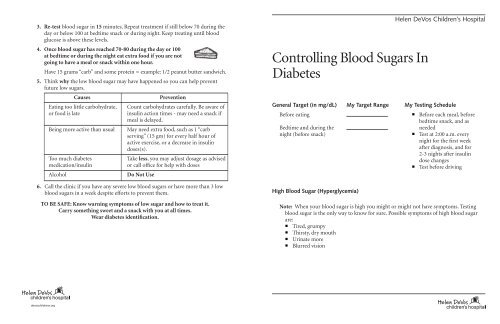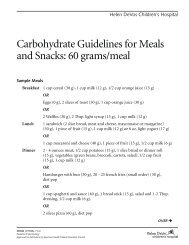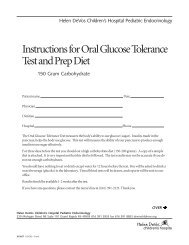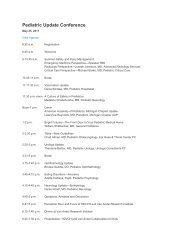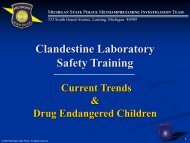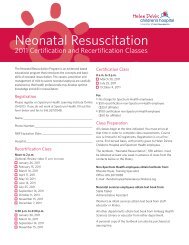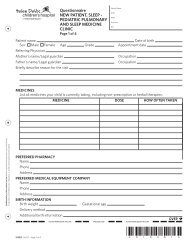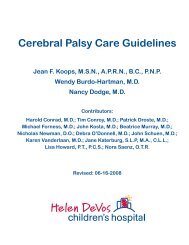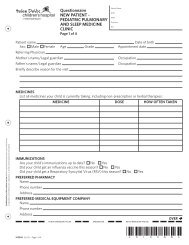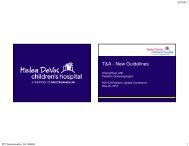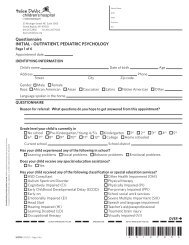Controlling Blood Sugars In Diabetes - Helen DeVos Children's ...
Controlling Blood Sugars In Diabetes - Helen DeVos Children's ...
Controlling Blood Sugars In Diabetes - Helen DeVos Children's ...
You also want an ePaper? Increase the reach of your titles
YUMPU automatically turns print PDFs into web optimized ePapers that Google loves.
3. Re-test blood sugar in 15 minutes. Repeat treatment if still below 70 during theday or below 100 at bedtime snack or during night. Keep treating until bloodglucose is above these levels.4. Once blood sugar has reached 70-80 during the day or 100at bedtime or during the night eat extra food if you are notgoing to have a meal or snack within one hour.Have 15 grams “carb” and some protein = example: 1/2 peanut butter sandwich.5. Think why the low blood sugar may have happened so you can help preventfuture low sugars.CausesPreventionEating too little carbohydrate,or food is lateBeing more active than usualToo much diabetesmedication/insulinAlcoholCount carbohydrates carefully. Be aware ofinsulin action times - may need a snack ifmeal is delayed.May need extra food, such as 1 “carbserving” (15 gm) for every half hour ofactive exercise, or a decrease in insulindoses(s).Take less, you may adjust dosage as advisedor call office for help with dosesDo Not Use6. Call the clinic if you have any severe low blood sugars or have more than 3 lowblood sugars in a week despite efforts to prevent them.To Be Safe: Know warning symptoms of low sugar and how to treat it.Carry something sweet and a snack with you at all times.Wear diabetes identification.<strong>Controlling</strong> <strong>Blood</strong> <strong>Sugars</strong> <strong>In</strong><strong>Diabetes</strong>General Target (in mg/dL) My Target Range My Testing ScheduleBefore eatingBedtime and during thenight (before snack)High <strong>Blood</strong> Sugar (Hyperglycemia)<strong>Helen</strong> <strong>DeVos</strong> Children’s Hospital• Before each meal, beforebedtime snack, and asneeded• Test at 2:00 a.m. everynight for the first weekafter diagnosis, and for2-3 nights after insulindose changes• Test before drivingNote: When your blood sugar is high you might or might not have symptoms. Testingblood sugar is the only way to know for sure. Possible symptoms of high blood sugarare:• Tired, grumpy• Thirsty, dry mouth• Urinate more• Blurred visiondevoschildrens.org
If your blood sugar is high:1. Drink more water.2. Test your blood sugar 4 or more times a day and look for trends.3. Test for ketones when blood sugars are over 240 or during illness. You want toavoid keto-acidosis. This may occur when blood sugars are high, and ketonesare present. The symptoms of high blood sugar get worse and you may alsodevelop:• Stomachache, Nausea, Vomiting• Hard, fast breathing, breath smells sweet• <strong>In</strong>creasing drowsinessExtra insulin and sugar free liquids will be needed. Call the doctor on call forhelp (see below)4. Problem Solve - try to determine why blood sugar is high and treat the cause.Possible Causes of High <strong>Blood</strong> SugarToo much food (carbohydrates)Less activityNot enough diabetes medicineStress/Illness/<strong>In</strong>fectionGrowth spurt/Adolescence5. Contact us:What To DoCount carbs carefullyBe more active. Do notexercise if ketones are present.Take insulin/medications asdirected. You may need achange in the dose, or timingof medicine.Refer to handout “Sick DayRules”More medicine/insulin may beneeded, watch blood sugarsfor trends.• Call the emergency number, 391-1774, and ask for the pediatric diabeteson call staff if any vomiting or ketones present• Call the <strong>Diabetes</strong> Educator's desk at (616) 391-3933 ifblood sugar patterns are outside of goal ranges forseveral days despite your efforts.Low <strong>Blood</strong> Sugar (Hypoglycemia)Happens Suddenly!• Hard to concentrate or think clearly• Grouchy, irritable• Shaky, nervous, sweaty• Weak, dizzy, sleepy, poor coordination• Hunger• Pale skin• Restless sleepDo Not Ignore! You could become confused or even pass out!Do This Now:1. Test blood sugar if you can.2. Do a “15/15 Fix” (Take 15 grams carbohydrate and wait 15 minutes):Take 15 grams of carbohydrate now if blood sugar is:• less than 70 or 70 - 80 with symptoms, or• less than 100 before bed or during night, or• you feel low, but can’t testExamples of 15 grams of carbohydrate:• 3-4 glucose tablets• 4 oz. fruit juice or regular pop• 5 Mentos, or 4 Starbursts, or check nutrition label onother soft candies of fruit snacks• 1 cup (8 oz.) no fat milk or gatoradeNote:• Don't use chocolate or high fat foods to treat low sugar as the fat slowssugar absorption.• If blood sugar is under 50 double the treatment to take 30 grams ofcarbohydrate (do not use milk)• Do not take insulin for carbohydrates that are used :• to treat a low blood sugar, or• as snacks for exercise to prevent low blood sugar.• If too drowsy to swallow, do not put anything in mouth. Give Glucagon<strong>In</strong>jection or call 911 right away! (Refer to "How to Treat a Child WithSevere Low <strong>Blood</strong> Sugar <strong>In</strong> <strong>Diabetes</strong>" instruction sheet)X01412 (©3/09) - (Spanish X09756)Pediatric EndocrinologyMichael A. Wood, MD Daniel C. Postellon, MD Bruce E. Wilson, MD A. Pinar Cemeroglu, MD Michael S. Racine, MDGrand Rapids MI 49503 616 391 3933 fax 391 6240 devoschildrens.orgApproved for distribution by Spectrum Health Patient Education Council


